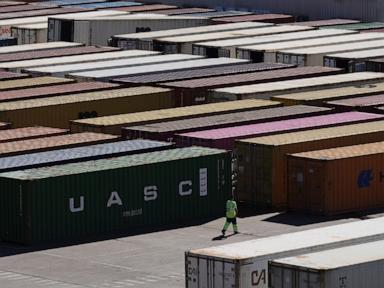Now Reading: US, global economic outlook worsens in the face of Trump’s tariffs, IMF says
-
01
US, global economic outlook worsens in the face of Trump’s tariffs, IMF says
US, global economic outlook worsens in the face of Trump’s tariffs, IMF says

The International Monetary Fund announced on Tuesday that the economic prospects for both the United States and the global economy have significantly deteriorated due to President Donald Trump’s tariffs and the resulting uncertainty. According to the latest World Economic Outlook, the IMF predicts that global economic growth will be only 2.8% this year, a decrease from its previous forecast of 3.3% in January. The forecast for 2026 global growth has also been revised down to 3% from the previous estimate of 3.3%.
In the United States, economic growth is expected to reach just 1.8% this year, a sharp decline from the earlier projection of 2.7% and a full percentage point below the 2024 expansion. While the IMF does not anticipate a U.S. recession, it has raised the likelihood of one happening this year from 25% to 37%.
The IMF’s forecasts align closely with the expectations of many private-sector economists, with some expressing concerns about an impending recession. Economists at JPMorgan now believe there is a 60% chance of a U.S. recession. The Federal Reserve has also predicted a weakening growth rate of 1.7% for this year.
Pierre-Olivier Gourinchas, the IMF’s chief economist, remarked that the global economic landscape is undergoing a transformation. The IMF, a lending organization representing 191 nations, works to stimulate economic growth, ensure financial stability, and alleviate global poverty.
Gourinchas highlighted that the heightened uncertainty surrounding import taxes prompted the IMF to prepare multiple growth scenarios. Although the U.S. imposed sweeping tariffs on nearly 60 countries, the IMF’s forecasts, which were finalized on April 4, remained largely unchanged even after the temporary pause in tariffs announced on April 9, as the U.S. and China had already implemented significant tariffs on each other.
The IMF cautioned that the uncertainty over the Trump administration’s trade policies could weigh heavily on both the U.S. and global economies. This uncertainty might lead companies to delay investment and expansion plans, potentially slowing down economic growth.
Furthermore, China’s growth is expected to be impacted by U.S. tariffs, with the IMF revising its growth forecast to 4% for this year and next, a decrease from previous estimates. The U.S. economy is likely to face a “supply shock,” akin to the pandemic’s impact, which could increase inflation. On the other hand, China may experience reduced demand as U.S. imports decline.
The IMF foresees inflation in the United States rising to around 3% by the end of the year, while inflation in China is expected to remain relatively stable. The European Union’s growth rate is projected to slow down, but the impact of tariffs is not as severe as in China due to lower U.S. duties. Additionally, increased government spending by Germany may help offset some of the tariff-related effects.
The eurozone economies are forecasted to expand by 0.8% this year and 1.2% next year, a slight decrease from the IMF’s January projections. Japan’s growth forecast has also been revised downward to 0.6% for this year and next, down by 0.5% and 0.2% compared to earlier estimates.






